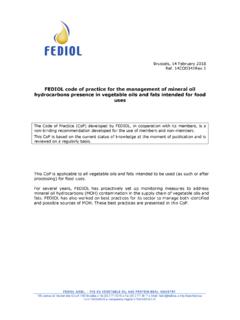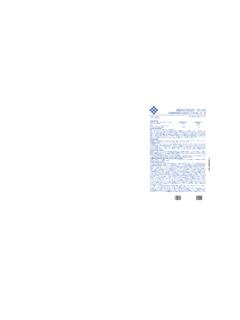Transcription of Oil Content Analysis: Myths and Reality - Free
1 Chapter 6. Oil Content analysis : Myths and Reality Barthet and Daun Canadian Grain Commission, Grain Research Laboratory, Winnipeg, Manitoba R3C 3G8, Canada Abstract The FOSFA (Federation of Oils, Seeds and Fats Associations Limited) extraction method (harmonized as AOCS Am 2-93 or ISO 659) is considered to be the refer- ence method to measure the oil Content of oilseeds. The method is based on the extraction of neutral lipids with hexane or petroleum ether, and the extracted com- ponents are estimated gravimetrically and defined as crude fat or oil Content .
2 The method requires a triplicate grind/extraction, making it lengthy and very detailed for the analyst. Compared with other official methods (AOAC ), the FOSFA extraction method gave the highest oil recoveries in all oilseeds tested. Accelerating the extraction through the use of new instrumentation, which com- bines solvent extraction with a physical disruption such as pressure or microwave heating, has not been able to give oil recovery equal to the FOSFA extraction. Although the FOSFA method remains the reference method, both ISO and AOCS.
3 Have identified a need to develop new rapid methods for oil extraction that yield oil equivalent to that from the FOSFA method and that can be used for determina- tion of other factors such as methyl esters or free fatty acids. This study examined the lipid components extracted by each stage of the FOSFA method: First Extraction (FOSFA1), Second Extraction (FOSFA2), and Third Extraction (FOSFA3). In a typical analysis , FOSFA1 accounted for ~86%, FOSFA2 for ~ , and FOSFA3 for as much as of the total oil extracted.
4 Although mainly triacylglycerols (TAG) were found, the extracts contained small amounts of other lipid components including nonesterified fatty acids, partial glycerides, fat-soluble vitamins, long-chain alcohols or aldehydes, and sterol or cholesterol esters. More nonpolar material was extracted in the first early stage of the extrac- tion, whereas the later stages contained more polar material. The oil in FOSFA1. and FOSFA2 contained close to 98% TAG based on methyl ester determination. The analyses of the phosphorus Content by graphite furnace atomic absorption spectrophotometry showed that almost no phosphorus (below limit of detection).
5 Was found in FOSFA1 and FOSFA2 oils but small amounts of phosphorus were present in FOSFA3 oils. This indicates that only ~ of phospholipids were pre- sent in the FOSFA3 oils, suggesting that only very small amounts (< ) of phospholipids are extracted by the total method when the three extracts are com- Copyright 2004 AOCS Press bined. Moreover, during the extractions of canola by the FOSFA method, the pro- portion of triacylglycerol (TAG) with n-7 fatty acids increased with each step of the process.
6 These fatty acids are associated with the seed coat in canola seeds, and the increase suggests that these structural lipids are the last lipids to be extracted. Introduction The term oil refers to a mixture of lipids that is liquid at room temperature and usu- ally of plant origin. According to Gunstone and Hersl f (1), oil Content is the ana- lytical quantity of oil obtained from plant sources (seed or endosperm). It is defined by both the source material and the extraction procedure. Different oil con- tents may be obtained from the same seed sample if the extractions use organic sol- vents of different polarity and/or different conditions of pressure and temperature.
7 For example, if other conditions are the same, using ethyl ether as the extraction solvent will likely give a higher oil Content than using petroleum ether because the more polar ethyl ether extracts more polar For an oil processor, there is a direct relation between seed oil Content and economic value. For soft oilseeds such as canola, the relative value of oil to meal may be as large as 8:1. If canola oil is sold at $500/tonne, the difference in value obtained between a tonne of seed at 40% oil and a tonne of seed at 41% oil is ~$5.
8 For a nutritional scientist, oil Content is related to energy intake and is part of the description of the nutritive value of the product. For a food scientist, oil Content is linked to important functional and organoleptic qualities of the food. For a crusher, the oil Content gives an estimate of the yield of a given batch; therefore, the oil Content is an economic characteristic of the oilseed trade. To satisfy all par- ties involved in the oilseed trade, it is important to have an analytical method that gives the real oil Content of the seeds.
9 Moreover, it is important to have this (these). methods standardized. For some researchers, however, it might be acceptable to give up a little bit of accuracy and precision in favor of a very rapid method. For example, plant breeders continually seek rapid methods for estimating oil Content . In the 1930s, researchers at the Canadian Grain Commission (2) developed a method using the refractive index of a hexane extract of flax seed. Others used the relationship between seed density and oil Content (3) or the amount of oil expressed onto paper by a hydraulic press (4).
10 For rapeseed, the first really useful rapid method for oil Content determination was the method developed by Tro ng (5), which was used at Sval v to analyze as many as 60,000 samples/y (6). The method was adopted in Canada as the Swedish method. A study carried out by the Associate Committee on Grain Quality in 1962 and 1963. 1 Itis important that the reader be aware of the difference between petroleum ether (also known as com- mercial hexane, or by commercial names such as SkellysolveTM) and diethl ether.








